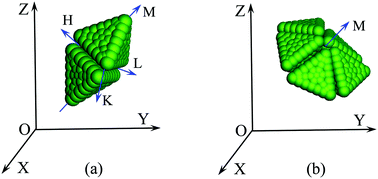DEM simulation of the local ordering of tetrahedral granular matter
Abstract
The formation and growth of local order clusters in a tetrahedral granular assembly driven by 3D mechanical vibration were captured in DEM (discrete element method) dynamic simulation using a multi-sphere model. Two important kinds of clusters, dimer and wagon wheel structures, were observed based on which the growth behavior and mechanism of each local cluster with different orientations/structures were investigated. The results show that during vibration, dimer clusters are formed first and then most of them grow into linear trimers and tetramers. Wagon wheel clusters are also frequently observed that grow into hexamers and, further, octamer and nonamer local clusters. Coordination number (CN) evolution indicates that the decrease of local mean CN can be regarded as the signal for the formation of local clusters in the tetrahedral particle packing system. Nematic order metric analysis shows that although the two basic structures (dimer and wagon wheel structures) grow into complex local clusters during packing densification, these local clusters are randomly distributed in the tetrahedral particle packing system. Stress analysis indicates that the dimer-based local clusters are mostly formed in the compaction state of the tetrahedral particle packing system during the vibrated packing densification process. In comparison, the wagon wheel-based local clusters need much stronger interaction forces from tetrahedral particles during vibrated packing densification.



 Please wait while we load your content...
Please wait while we load your content...